Physicist: The weird effects that show up in quantum mechanics (a lot of them anyway) are due to the wave-nature of the world making itself more apparent. What we normally think of as “particle behavior” is just what happens when the waves you’re talking about are very small (compared to what’s around) and are “decoherent” (which means the frequency, phase, and polarization are all pretty random between one photon and the next). It’s a long way from obvious (there’s some math) but, for example, the way light streams through gaps is governed entirely by the wave-nature of light, and not because it’s a particle.

It looks like the sunlight is made of particles moving in straight lines, but in reality you don’t need “particleness” to describe what’s happening here. The gaps in the door are very large compared to the wavelength of the light (approx. 0.01 m vs. 0.0000005 m). With enough elbow room, waves will proceed in a straight line due to interference effects.
Technically, absolutely everything is fundamentally quantum mechanical. What we consider to be “classical mechanics” is just a special case of quantum mechanics (a large-scale, non-coherent case).
But that’s not at the heart of this question.
Light wears its quantum behavior proudly. The De Broglie wavelength decreases with increasing mass, and while even the lightest particles have fantastically small wavelengths (electrons typically have wavelengths on the order of trillionths of a meter), light can have wavelengths ranging up to miles long (radio waves). Observing quantum effects in matter is difficult, but we see it in light so much that we think it’s normal (which it is, I suppose).
So, other than obvious stuff; like chemistry or… absolutely everything, what follows are some distinctly wavy and quantumy things that you might come across while palling around on this big blue world. Also, this list is far more incomplete than complete, so I’m open to suggestions for things to add.
Technology younger than fifty years old (give or take)
There are a lot of well-established, well-known (in the scientific community) quantum mechanical effects that are in use in almost every fancy device devised since the forties. This include things like lasers (Bose-Einstein statistics), tunnel diodes (quantum tunneling), LED lights, and of course exotic stuff like quantum computers. Unfortunately, the qunatum-ness of modern technology is generally pretty well hidden (and thus: boring).
Using cell phones inside (diffusion)
Ever successfully use a cell phone while inside? Radio waves are huge, so their waveness is very apparent. They can ooze around corners (to some extent), and permeate (non-conductive) materials. It’s a little tricky to describe why radios (including cells phones, wifi signals, etc.) work even when there’s no line-of-sight between the sender and receiver, and especially tricky to describe why they work when there’s no path at all (for example, being in a windowless room with the door closed). I wish I could say it’s quantum tunneling (because that would be awesome), but it’s not quite that. It’s similar to the fact that very long, slow ocean waves will cause your boat to rise and fall as a whole, but very short ocean waves are blocked by things like a boat. Radio waves tend to be about the size of buildings and when they come along, rather than just hitting the walls and bouncing off or getting absorbed, they “raise and lower” the electromagnetic field of the whole area. Already it’s practically impossible to describe radio waves in terms of particles.
Pretty colors (thin-film interference)
There’s an optical device called a “Fabry–Pérot interferometer” which uses wave interference to separate out light of very, very nearly equal frequencies, and it’s basically just two mirrors.
As it happens, thin films of transparent material mimic the F-P interferometer.
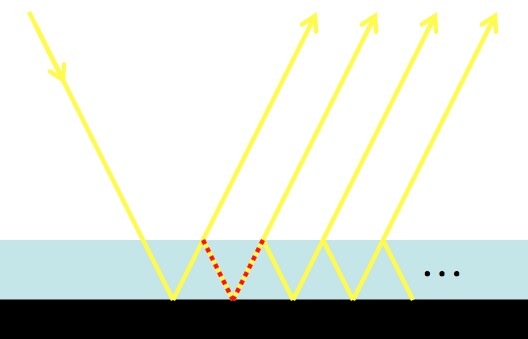
Some light will bounce off of the surface of the film, and some will go through. If the extra length between paths (red dotted line) is a multiple of the light’s wavelength, then you get “constructive interference”. When you get “destructive interference” then there won’t be light reflected at that angle.
Which of the incoming and outgoing angles experiences constructive interference depends on the thickness of the film, the material of the film, and the color of the light. If the light is “monochromatic” (one color or wavelength, like a laser), then this leads to dark areas. If the light has many different colors, then the areas that are dark for some colors may not be dark for others (which leads to prettiness, see the picture below).
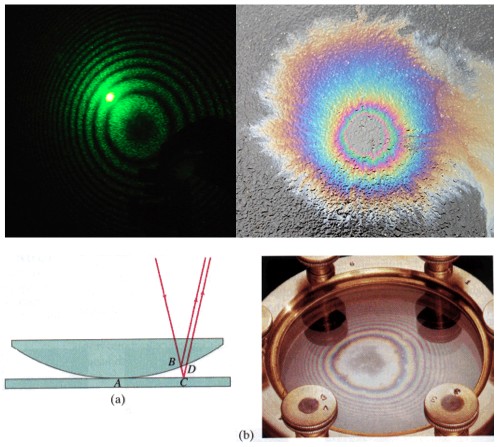
Light can bounce back and forth inside of thin, flat, transparent films. Top Left: a green laser and the glass of a mirror. Top Right: sunlight and an oil film on water. Bottom Left: The path diagram for… Bottom Right: “Newton’s rings”.
It’s sometimes hard to see, but you can see thin-film effects in soap bubbles as well. In that case the thickness of the film tends to change rapidly, which is why the colors in soap films tend to swirl and change so fast.
True rainbows are formed by another process, but they also ultimately rely on the wave nature of light. It’s just a bit more obscure how.
Dark spots on still lakes (Brewster’s angle and polarized light)
This one is pretty hard to notice. In addition to light’s waviness, it also has polarization (which is a fundamentally not-particle thing to have). The polarization of light affects how it reflects off of a surface (like water) and how it scatters in a gas (like air). If you happen to look at the sky reflecting off of a lake these effects are combined, and at one particular angle they fight each other.
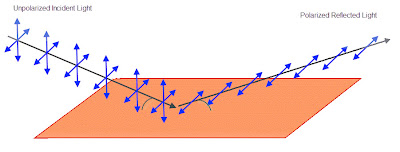
If the angle between the incoming light and the surface of the water is 37°, then only horizontally polarized light will reflect.
The amount of light that reflects off of a surface depends on the polarization of that light, which is why polarized glasses are sold to drivers to cut down on glare. It so happens that if vertically polarized light hits water at about 37° none of it will be reflected (this is called “Brewster’s angle“).
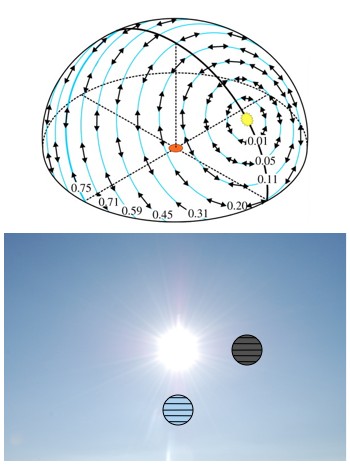
A map of the polarization of the sky (top). The polarization of the blue of the sky “circles the Sun”. So, if you hold up a horizontal polarizer below the Sun it’ll appear clear, but if you hold it up by the side of the Sun it’ll appear dark (bottom).
Because of the way light scatters in air, if you point your hand at any point in the sky (other than the Sun), and turn your palm toward the Sun, then the flat of your hand will be aligned with the polarization of the light coming from that part of the sky. As a result, right around dawn and dusk the entire sky is polarized in the north-south direction.
One consequence of this is that if you’re standing at the right angle early or late in the day, and the sky (not the Sun) is your primary light source, then the face on your digital watch can appear black. Another is that if you look at the sky in a still lake, at about 37° from level, during dawn or dusk, while looking either north or south, you’ll find that the sky isn’t reflected at all and appears black.
For some reason I like this example, in part because it must have been confusing as hell for the occasional fishermen who noticed this over the millennia. However, like the green flash, it’s one of those effects that’s not quite an every-day example.
The door picture is from here, the oil picture is from here, the soap-bubble picture and a description of how it was made can be found here, the reflection picture is from here, and the green-laser-mirror-picture was sent in by a kind-hearted reader as part of a question. The map of the polarizations is from this paper about how bees use that very polarization to navigate. That’s worth pointing out again; many insect species can literally see the polarization of light.

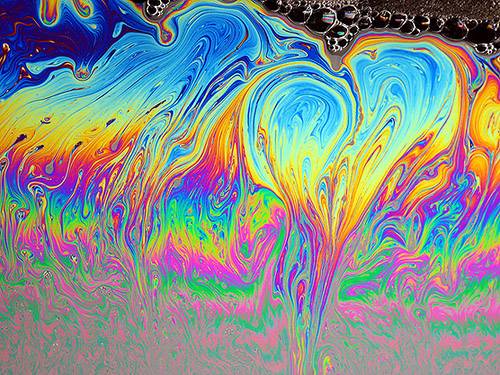






Pingback: Q: What are “actual pictures” of atoms actually pictures of? | Ask a Mathematician / Ask a Physicist
Pingback: ميكانيكا الكم: هل يمكنن إيجاد أمثلة يومية عنها أم أن رؤيتها لا تتم خارج المختبر؟ - أنا أصدق العلم